The Access View in Which You Can Make Changes to a Form or Report While the Object
Lesson four: Introduction to Objects
/en/access2013/introduction-to-databases/content/
Introduction
Databases in Access are equanimous of four objects: tables, queries, forms, and reports. Together, these objects let y'all to enter, store, analyze, and compile your information nonetheless you want.
In this lesson, you will learn about each of the four objects and come to understand how they interact with each other to create a fully functional relational database.
Tables
By this point, you lot should already understand that a database is a collection of data organized into many connected lists. In Access, all data is stored in tables, which puts tables at the heart of any database.
You might already know that tables are organized into vertical columns and horizontal rows.
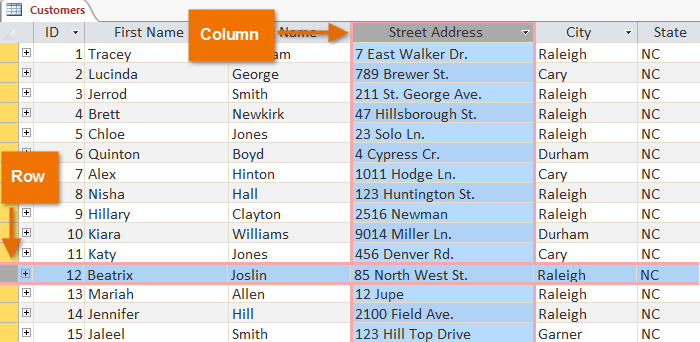 Rows and columns in an Admission tabular array
Rows and columns in an Admission tabular array
In Admission, rows and columns are referred to as records and fields. A field is more than than simply a column; it's a mode of organizing information by the type of data it is. Every piece of information inside a field is of the same blazon. For example, every entry in a field called First Name would be a name, and every entry in field called Street Address would be an accost.
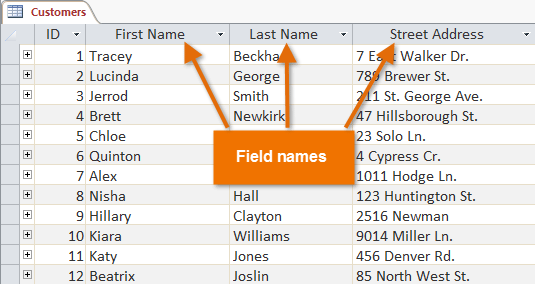 Fields and field names
Fields and field names
Likewise, a tape is more than merely a row; it'south a unit of information. Every cell in a given row is part of that row's tape.
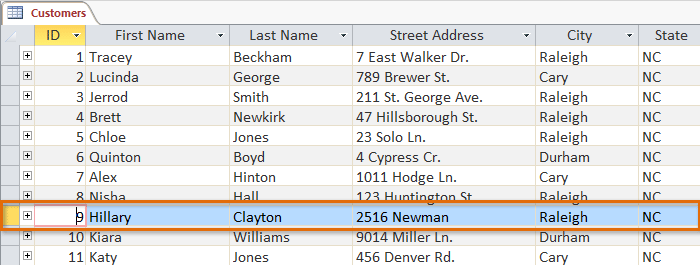 A record
A record
Observe how each record spans several fields. Even though the information in each record is organized into fields, it belongs with the other information in that record. See the number at the left of each row? Information technology'south the ID number that identifies each record. The ID number for a record refers to every slice of information contained on that row.
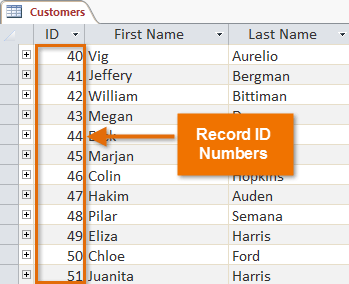 Record ID numbers
Record ID numbers
Tables are skilful for storing closely related data. Let's say you ain a baker and have a database that includes a table with your customers' names and information, like their phone numbers, dwelling house addresses, and electronic mail addresses. Because these pieces of data are all details on your customers, yous'd include them all in the same table. Each customer would be represented by a unique record, and each type of information nigh these customers would be stored in its own field. If you lot decided to add whatever more data—say, a customer'south birthday—you would simply create a new field within the aforementioned table.
Forms, queries, and reports
Although tables store all of your data, the other three objects—forms, queries, and reports—offer you means to piece of work with it. Each of these objects interacts with the records stored in your database'southward tables.
Forms
Forms are used for entering, modifying, and viewing records. You likely have had to fill out forms on many occasions, similar when visiting a doctor's office, applying for a job, or registering for school. The reason forms are used so oftentimes is that they're an easy way to guide people toward entering information correctly. When you lot enter information into a form in Access, the data goes exactly where the database designer wants information technology to become: in one or more than related tables.
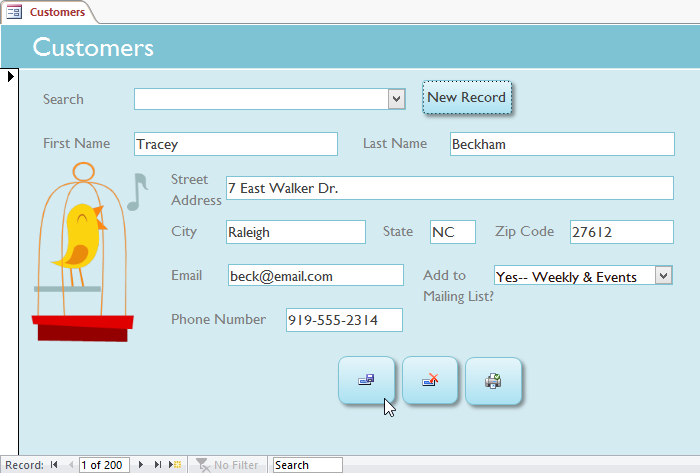 A form
A form
Forms make entering data easier. Working with extensive tables tin be confusing, and when y'all have continued tables you might need to work with more one at a time to enter a ready of data. Yet, with forms it'due south possible to enter data into multiple tables at once, all in one place. Database designers tin even set restrictions on individual form components to ensure all of the needed data is entered in the correct format. All in all, forms help keep data consistent and organized, which is essential for an accurate and powerful database.
Queries
Queries are a mode of searching for and compiling information from 1 or more than tables. Running a query is like asking a detailed question of your database. When you build a query in Access, you are defining specific search conditions to find exactly the data you want.
Queries are far more powerful than the simple searches you might carry out within a tabular array. While a search would be able to assist you lot discover the name of one customer at your business concern, you lot could run a query to find the name and phone number of every customer who's made a purchase within the past week. A well-designed query can give information you might not exist able to discover merely by looking through the data in your tables.
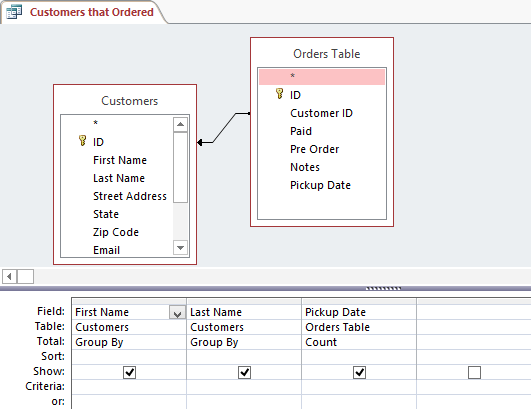 Designing a query
Designing a query
Reports
Reports offer you the power to present your data in print. If you lot've ever received a computer printout of a class schedule or a printed invoice of a purchase, you lot've seen a database report. Reports are useful because they allow you to nowadays components of your database in an easy-to-read format. You tin can fifty-fifty customize a written report'due south appearance to make it visually appealing. Access offers you the ability to create a report from whatsoever tabular array or query.
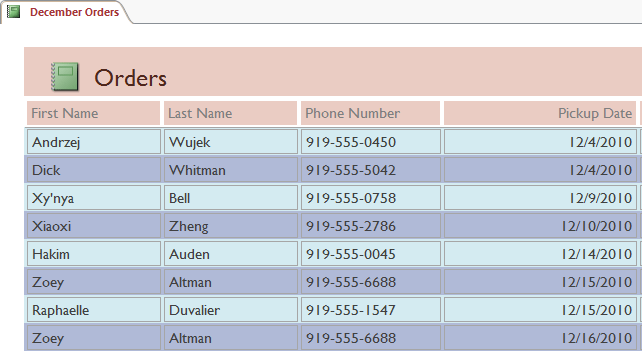 A study
A study
Putting it all together
Even if y'all have a good idea of how each object tin exist used, it tin can initially be difficult to understand how they all piece of work together. It helps to remember that they all piece of work with the aforementioned data. Every slice of data a query, form, or report uses is stored in 1 of your database tables.
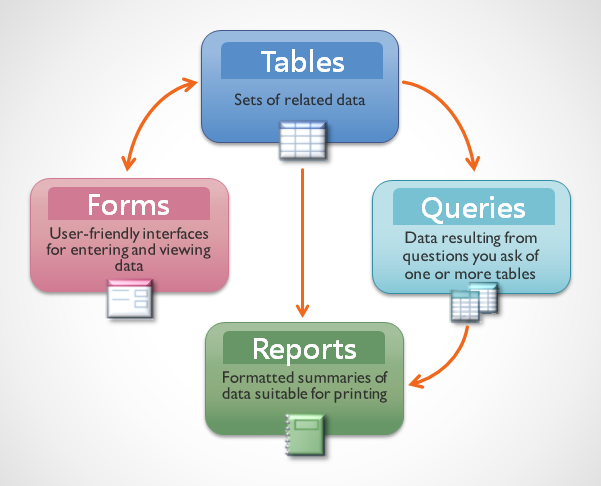 The four Access objects
The four Access objects
Forms permit you to both add data to tables and view data that already exists. Reports present data from tables and also from queries, which then search for and analyze data within these aforementioned tables.
These relationships sound complicated, only in fact they work together so well and naturally that we often don't even observe when nosotros're using connected database objects. Take you ever used an electronic card catalog to search for a volume at the library? Chances are, yous entered your search in something that looks like this:
 An electronic carte du jour catalog
An electronic carte du jour catalog
When you performed your search, you were entering your search terms into a form that then created and ran a query based on your request. When the query finished searching the database's tables for records that matched your search, yous were shown a report that drew data from the query and the related tables—in this case, a listing of books matching your search terms. Yous could correspond the connections between the objects like this:
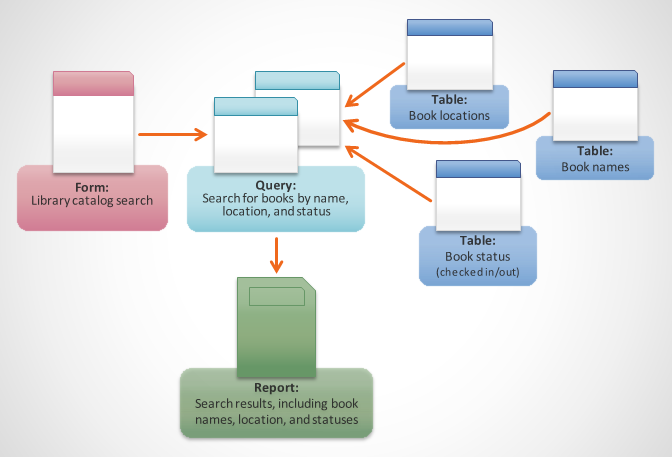 A search for a book. The data submitted in the class is used in a database query, which draws its information from relevant tables. The results of the query are presented in a report.
A search for a book. The data submitted in the class is used in a database query, which draws its information from relevant tables. The results of the query are presented in a report.
Allow'southward say instead of using these tools yous had to search within a behemothic tabular array containing every volume in the library system. The relevant records would likely be spread out across many tables: a table for book titles and descriptions, a tabular array containing information on which books are checked in or out, and a table with each branch of the library, only to name a few.
Y'all'd accept to search at least 3 tables just to discover a book, learn its location, and meet whether it's checked in! It'south easy to imagine how hard it could become to observe the correct book. If you lot weren't conscientious, y'all might even mess something upwardly past accidentally deleting or editing a record. Information technology's easy to come across how the database objects make this search much more manageable.
In our Introduction to Databases lesson, we discussed the concept of a relational database, which is a database that is able to understand how different sets of data relate to one some other. Situations like the example above are exactly why people detect relational databases and then useful. Without a relational database, what should exist a elementary job—searching for a book and seeing if information technology's checked in and where—becomes incredibly complicated and time consuming. Knowing how to employ the four Admission objects can make even complicated tasks fairly user friendly.
/en/access2013/getting-started-with-access/content/
lopezdremetweithe.blogspot.com
Source: https://edu.gcfglobal.org/en/access2013/introduction-to-objects/1/
0 Response to "The Access View in Which You Can Make Changes to a Form or Report While the Object"
Post a Comment